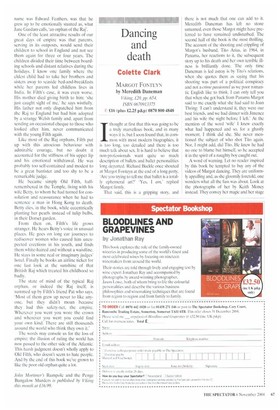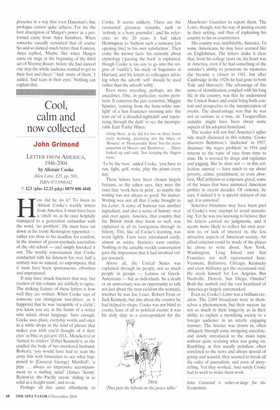Dancing and death
Colette Clark
MARGOT FONTEYN by Meredith Daneman
,C20, pp. 654, ISBN 0670913375
£16 (plus £2.25 p&p) 0870 800 4848 Ithought at first that this was going to be a truly marvellous book, and in many ways it is, but I soon found that, in common with most modern biographies, it is too long, too detailed and there is too much talk about sex. It is hard to believe that non-professionals want quite so much description of ballets and ballet personalities long departed. Richard Buckle once shouted at Margot Fonteyn at the end of a long party, Are you trying to tell me that ballet is a totally ephemeral art?"Yes, 1 am,' replied Margot firmly.
That said, this is a gripping story, and .._
there is not much that one can add to it. Meredith Daneman has left no stone unturned, even those Margot might have preferred to have remained undisturbed. The second half of the book is the most thrilling. The account of the shooting and crippling of Margot's husband, Tito Arias, in 1964, in Panama, her reactions to it, the subsequent story up to his death and her own terrible illness is brilliantly done. The only time Daneman is led astray is by Tito's relations, when she quotes them as saying that his shooting was part of a political conspiracy and not a Ctirrie pas.sionnel as we poor romantic English like to think. I can only tell you that when she got back from Panama Margot said to me exactly what she had said to Joan Thring: 'I can't understand it, they were our best friends, and we had dinner with Jimenez and his wife the night before I left.' At the mention of the word 'wife' I knew exactly what had happened and so, for a ghastly moment, I think did she. She never mentioned the subject of who shot Tito again, Nor, I might add, did Tito. He knew he had no one to blame hut himself, so he accepted it in the spirit of a naughty boy caught out.
A word of warning. I.et no reader inspired by this book be tempted to buy any of the videos of Margot dancing. They are uniformly appalling and, as she gloomily foretold, one wonders what all the fuss was about. Look at the photographs of her by Keith Money instead. They convey her magic and her stage presence in a way that even Daneman's fine prologue cannot quite achieve. For me the best description of Margot's power as a performer came from Anya Sainsbury. When someone casually remarked that of course So-and-so danced much better than Fonteyn, Anya replied, 'Maybe. But when Margot came on stage at the beginning of the third act of Sleeping Beauty, before she had danced one step the whole audience wanted to get to their feet and cheer.' And many of them,' I added, 'had tears in their eyes.' Nothing can explain that.



























































































































 Previous page
Previous page